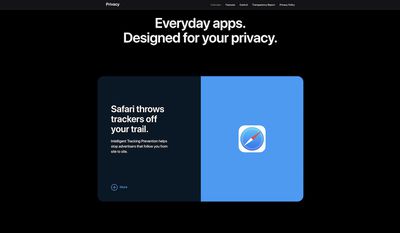Apple's Revamped Privacy Site Highlights 'Everyday Apps, Designed for Your Privacy'
Apple today announced an update to its privacy website that touches on various new privacy benefits found in iOS 13, iPadOS 13, watchOS 6, and more. Apple's updated website includes white papers on how the company approaches privacy in Safari, Sign in with Apple, Location Services, and Photos, providing visitors with a deeper insight into the company's privacy mission.

The website reinforces Apple's four core privacy principles: minimizing the data collected from users, processing the data on the device when possible, transparency when collecting data and how it's used, and strong device encryption. You can visit the website for yourself at Apple.com/privacy, which is now highlighting iOS apps like Maps, Photos, and Messages, and how they each enhance iPhone users' privacy.
According to Apple, there are multiple recent privacy and security innovations that it has accomplished with its latest software updates:
- Contacts: Any notes stored in the notes section of the Contacts app will not be shared with third party applications when they are granted access to the Contacts app.
- Find My: Apple uses end-to-end encryption to communicate with other Apple devices nearby in order to find lost iPhones and Macs, ensuring that it doesn't know the location of the device or the identity of the device that discovered it.
- Arcade: No advertising or third-party tracking is ever permitted.
- Background tracking notifications: iPhone owners now get notifications when apps are using their location in the background, providing them with a chance to turn this feature off.
You can click on different tabs on the website to view the new white papers for services like Safari, Face ID, Location Services, and more. While the website itself remains a straightforward look at how Apple handles user data, each white paper offers a more nuanced dive into specific programs and services at Apple, and how the company is aiming to enhance privacy with every new update.
The site also includes a tab for its transparency reports, showcasing how Apple is committed to being transparent about responding to government requests for user data around the world. Here you can scroll through each region to see how often Apple has shared user data with the local government, beginning as far back as 2013 and stretching to 2018.
Popular Stories
Apple is preparing a "bold" new iPhone Pro model for the iPhone's 20th anniversary in 2027, according to Bloomberg's Mark Gurman. As part of what's being described as a "major shake-up," Apple is said to be developing a design that makes more extensive use of glass – and this could point directly to the display itself.
Here's the case for Apple releasing a truly all-screen iPhone with no...
While the iPhone 17 Pro and iPhone 17 Pro Max are not expected to launch until September, there are already plenty of rumors about the devices.
Below, we recap key changes rumored for the iPhone 17 Pro models as of April 2025:
Aluminum frame: iPhone 17 Pro models are rumored to have an aluminum frame, whereas the iPhone 15 Pro and iPhone 16 Pro models have a titanium frame, and the iPhone ...
The first iOS 19 beta is less than two months away, and there are already a handful of new features that are expected with the update.
Apple should release the first iOS 19 beta to developers immediately following the WWDC 2025 keynote, which is scheduled for Monday, June 9. Following beta testing, the update should be released to the general public in September.
Below, we recap the key...
If you have been experiencing issues with wireless CarPlay in your vehicle lately, it was likely due to a software bug that has now been fixed.
Apple released iOS 18.4.1 today, and the update's release notes say it "addresses a rare issue that prevents wireless CarPlay connection in certain vehicles."
If wireless CarPlay was acting up for you, updating your iPhone to iOS 18.4.1 should...
Apple's iPhone development roadmap runs several years into the future and the company is continually working with suppliers on several successive iPhone models simultaneously, which is why we often get rumored features months ahead of launch. The iPhone 17 series is no different, and we already have a good idea of what to expect from Apple's 2025 smartphone lineup.
If you skipped the iPhone...
Apple may have updated several iPads and Macs late last year and early this year, but there are still multiple new devices that we're looking forward to seeing in 2025. Most will come in September or October, but there could be a few surprises before then.
We've rounded up a list of everything that we're still waiting to see from Apple in 2025.
iPhone 17, 17 Air, and 17 Pro - We get...
Apple today released iOS 18.4.1 and iPadOS 18.4.1, minor updates to the iOS 18 and iPadOS 18 operating systems that came out last September. iOS 18.4.1 and iPadOS 18.4.1 come two weeks after the launch of iOS 18.4 and iPadOS 18.4.
The new software can be downloaded on eligible iPhones and iPads over-the-air by going to Settings > General > Software Update.
There have been complaints about ...
Apple today updated its vintage products list to add the 2018 Mac mini and the iPhone 6s, devices that will get more limited service and repairs now that they are considered vintage.
The iPhone 6s initially launched in 2015, but Apple kept it around as a low-cost device until 2018, which is why it is only now being added to the vintage list. The iPhone 6s had Apple's A9 chip, and it was...
Apple today released tvOS 18.4.1, a minor update to the tvOS 18 operating system that came out last September. tvOS 18.4.1 comes two weeks after Apple released tvOS 18.4, and it is available for the Apple TV 4K and Apple TV HD models.
tvOS 18.4.1 can be downloaded using the Settings app on the Apple TV. Open up Settings and go to System > Software Update to get the new software....
























